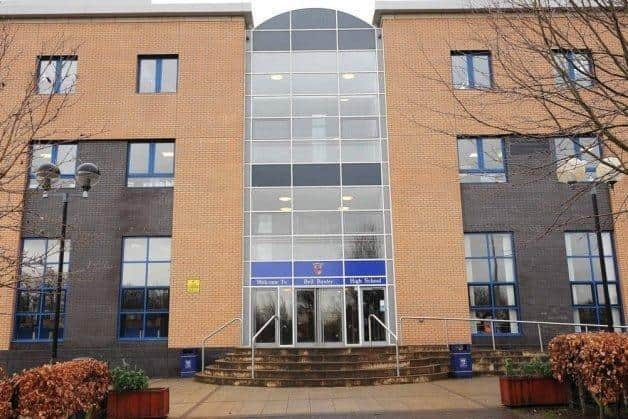Jenny Gilruth says some Scottish schools being 'too big' is contributing to behaviour and attendance problems
Education Secretary Jenny Gilruth has admitted she thinks some schools in Scotland are “too big” and that large pupil rolls are contributing to problems with behaviour and attendance.
The former teacher specifically named a number of schools in Fife, including newly-built secondaries, warning that large rolls can harm relationships with staff and leave some youngsters feeling “lost”.
Advertisement
Hide AdAdvertisement
Hide AdShe said she had asked officials to look at the issue, potentially leading to “clearer guidance” for local authorities in future.


It comes just a day after new statistics showed more than half of pupils in parts of Scotland were persistently absent last year.
The education committee at Holyrood has heard from several witnesses that the size and design of schools can be unhelpful for pupils with additional support needs (ASN), with one trade union official even claiming youngsters are being taught in corridors and cupboards.
SNP MSP Bill Kidd asked Ms Gilruth about the evidence, as she appeared before the committee on Wednesday.
The education secretary said she was “pretty sympathetic to it”, and was “very taken” with the evidence.
She said: "I’m a Fife MSP, and there are a number of large schools in the area of Fife, that the local authority has decided that’s the kind of approach they would like to education.
"I attended one of them. There are two – I think in Mr (Willie) Rennie’s constituency – very large schools, Madras and Bell Baxter. Levenmouth Academy, which brought two schools together, and also includes Fife College. We also have in Dunfermline a big campus with two secondary schools going into it, and Fife College.”
Bell Baxter High School in Cupar has a roll of about 1,400, while Madras College at St Andrews, where Ms Gilruth was a pupil, was recently at about 1,300, and Levenmouth Academy was over 1,600.
Advertisement
Hide AdAdvertisement
Hide AdMs Gilruth added: "I think there are some schools in Scotland that are too big. I think they are too big for our children with additional support needs, but I think they are too big for our pupils and our staff, full stop.
"And what that means is that teachers don’t get to know their children and young people in big schools. If you think about Fife, and the geography of that little area of Scotland – lots of little towns and villages coming together in a huge school – children become lost.
"When we talk about challenges associated with behaviour, attainment – this is all about relationships and your teachers knowing your kids. I think we need to get some further advice in relation to school design and I’ve asked officials to work on that via Scottish Futures Trust.”
Ms Gilruth also confirmed discussions were under way on the “next funding approach” for school building projects, following the £2billion learning estate investment programme, which ended in disappointment for many communities last year, as schemes failed to win support.
Mr Rennie, Lib Dem MSP for North East Fife, said “I’m afraid your predecessor, John Swinney, was insistent that the new high school in Dunfermline was a combined one, between St Columba’s and Woodmill, and also included Fife College, as a joint campus. He drove that against some resistance locally.”
Fife Council Leader David Ross said positive school communities are key to successful education and learning for our school pupils – not the size of the building.
He added: “Our school estate needs continual investment and funding and we have worked with Scottish Government for many years on our “Building Fife’s Future” school building programme to create new, state of the art modern campuses including the new Madras College. I’m therefore very surprised at this implied criticism by Ms Gilruth, particularly around our flagship Dunfermline Learning Campus which hasn’t even opened its doors yet.
“I think Ms Gilruth’s remarks are unfortunate as they give a very false impression of the nature of and vision for the school estate in Fife,
Advertisement
Hide AdAdvertisement
Hide Ad“All of our schools, including our larger schools, absolutely recognise that particular attention needs to be given to making sure every child has a sense of belonging.
“In renewing our school estate we work within the guidelines given by the Scottish Futures Trust. And all of our schools are designed to consider future demographics, so that they can fully accommodate those young people expected to be attending, ensuring the best outcomes for all young people, including those with specific additional support needs.”
“Establishing any link between a school’s size and its educational effectiveness is very difficult. Some of Scotland’s very largest schools and very smallest schools appear to be highly effective, when effectiveness is measured by success in external examinations.
“Factors other than size of roll, such as the quality of leadership and of learning and teaching, are significantly more important determinants of a school’s success. Larger schools can offer pupils more choice and greater flexibility.
“I think Ms Gilruth is treading very dangerous ground when she starts naming individual schools with little evidence to back up her assertions.
“Her reference to the new Dunfermline Learning Campus is particularly unfortunate when this is in fact includes two separate schools with relatively average rolls and has been held up by Ms Gilruth herself as a model of partnership between the local authority and Scottish Government.
“Fife does not have a policy approach that favours very large secondary schools but believes that any new secondary schools should have a minimum capacity of 800 pupils to offer breadth, balance, choice and coherence in the curriculum which pupils follow at the later stages. Very small secondary schools are expensive to run and require flexibility by staff and some limiting of pupils’ options if they are to run efficiently.”
Comments
Want to join the conversation? Please or to comment on this article.
